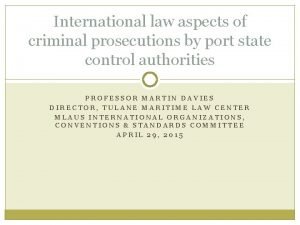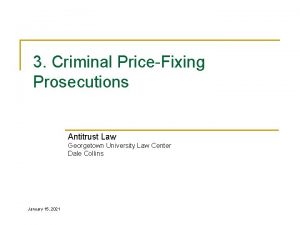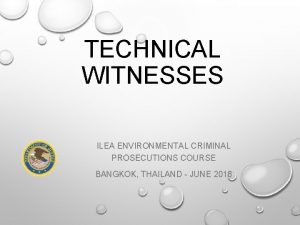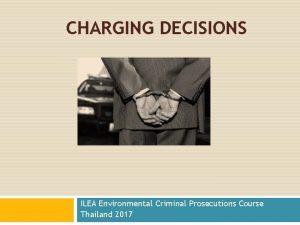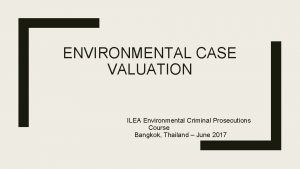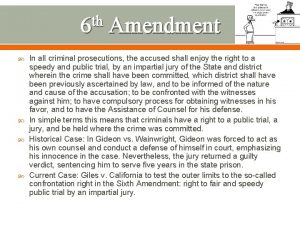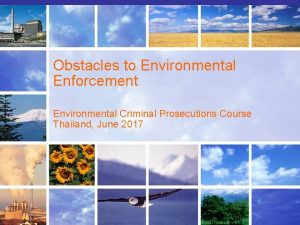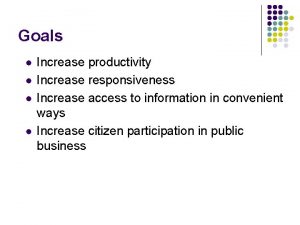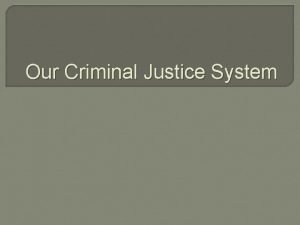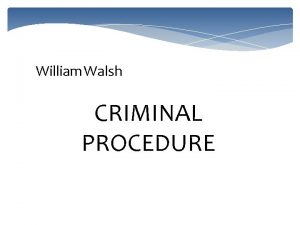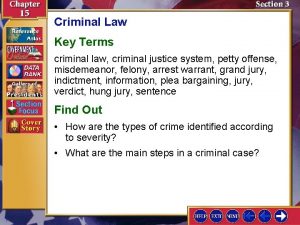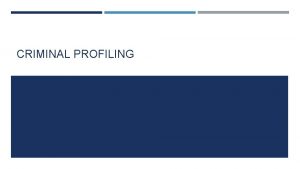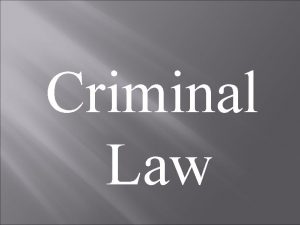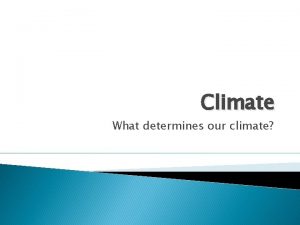The Climate Crisis The Increase of Criminal Prosecutions






































- Slides: 38

The Climate Crisis: The Increase of Criminal Prosecutions of Cross-Border Forest Crime and the Role of Environmental NGOs and Trade Agreements Bruce Zagaris Berliner Corcoran & Rowe L. L. P. 1101 Seventeenth St. , N. W. Washington, D. C. 20036 (202)293 -2371 (ph. ) (202)293 -9035 (fax) bzagaris@bcr-dc. com 1

Table of Contents I. Introduction. . . . 3 II. Cases. . . . . 6 Dejia Group. . . . . 6 Lumber Liquidators. . . . . 11 Oregon Popp. . . . . 13 Rosewood in Ghana. . . . 15 III. Trade Agreements. . . . 18 IX. Investigative techniques, incl. data analytics. . 29 2 X. Conclusion. . . . 35

I. INTRODUCTION Ø According to Earth. Day, deforestation is the second leading cause of global warming and produces about 24% of global greenhouse gas emissions. Ø Scientists say that deforestation in tropical rainforests adds more carbon dioxide to the atmosphere than the sum total of all the cars and trucks on the world’s roads. Ø In some countries, such as Brazil and Indonesia, deforestation and forest degradation together are by far the main source of national greenhouse gas emissions. 3

I. INTRODUCTION Ø As the climate crisis becomes more urgent, several environmental NGOs with the support of governments are proactively conducting investigations of illegal logging and trade in endangered species. Ø The sophistication of their investigative techniques (e. g. , use of data analytics and undercover sting operations) and publicizing their reports is exposing corruption, trade and tax crimes, and money laundering. Ø The reports and subsequent publicity is leading to increasing investigations and prosecutions. 4

I. INTRODUCTION Ø Between 20 and 50% of all timber traded internationally was harvested or traded illegally. Ø China is the largest market for Africa and accounts for 46% of exports in value (in 2016). Ø Asian entrepreneurs have acquired vast areas of tropical forest in the Congo Basin. 5

II. CASES Ø A. Dejia’s Allegedly Illegal Logging & Wood Trade Ø In March 2019, an illegal timber trade supply chain from Chinese companies operating out of two countries in West Africa to major hardware stores located throughout the U. S. has been uncovered. Ø A four-year investigation by the Washington, D. C. based Environmental Investigation Agency (EIA) uncovered evidence of illegal behavior by the Chinese-owned Dejia Group (DG). Ø They include concessions obtained through bribery, over-harvesting of trees, and tax evasion. 6

II. CASES Ø Dejia Group executives explained in detail to EIA undercover investigators how the company routinely bribes ministers in both Congo and Gabon to obtain access to timber concessions. Ø The EIA report and video documents the complicity of the U. S. main importer and connivance of a prominent manufacturer. 7

II. CASES Ø Dejia Group controls over 1. 5 m hectares in the Congo Basin. Ø EIA says it has operated for over 10 years w/o an approved forest management plan, against the sustainability principle of the national Forest Code. Ø Congo law allows export of only 15% of unprocessed wood, while Dejia has exported over 87% of unprocessed logs between 2013 -16. 8

II. CASES Ø Evergreen Hardwoods, Inc. Is the main U. S. importer of Dejia’s logs. Ø It is then distributed by a wide array of retail stores. Ø The Lacey Act requires due diligence by U. S. importers of timber products harvested, transported or sold in violation of state, foreign or international law. 9

II. CASES Ø EIA is calling for better enforcement of environmental law by the U. S. , the EU, and the P. R. C. , and better cooperation with Congo and Gabon to stop the illegal activities. Ø The allegations in the report have prompted investigations by ICE, DOJ, and Fish & Wildlife Service. Ø Since the publication, Roseburg, one of the timber companies importing Dejia logs has suspended the sale and manufacturing of its Dejia imports. 10

II. CASES Ø Gabon has suspended the logging permits of 2 companies, stopped the export of the logs, and started an investigation. Ø B. Lumber Liquidators Inc. Ø On Feb. 1, 2016, Lumber Liquidators Inc. agreed to pay more than $13 m in criminal fines and forfeitures to resolve a DOJ investigation into the import of wood. 11

II. CASES Ø It imported hardwood flooring manufactured in China from timber illegally logged in far eastern Russia, in the habitat of last remaining Siberian tigers and Amur leopards. Ø LL also agreed to a five-year term of organization probation and mandatory implementation of an environmental compliance plan and independent audits. 12

II. CASES Ø Tigers depend on intact forests for hunting and Mongolian oak acorns are a chief food source for the tigers’ prey species. Ø C. Seizure of Peru Timber for Oregon Popp Ø On Jan. 18, 2017, DOJ announced the seizure of 24 pallets of timber by HSI on Dec. 20, 2015, at the Houston Port for violation of the Lacey Act by Oregon-based Popp Forest Products Inc. 13

II. CASES Ø Allegations was based on report HSI obtained from the Peruvian government under a Customs MAA, showing the timber could not be the species authorized for harvest. Ø U. S. Forest Service’s Forest Product Lab corroborated the finding that samples taken from the shipment were not the species authorized for harvest. 14

II. CASES Ø D. Ghana’s Illicit Rosewood Trade ØOn Aug. 26, 2019, as a result of an EIA Report on illegal rosewood trade from Ghana to China, the Ghanaian Minister for Lands and Natural Resources announced the establishment of the “Committee to investigate Allegation of Corruption in Rosewood Trade in Ghana. ” 15

II. CASES Ø The decision by the Ghanaian government to start investigations results from the publication on July 30 by EIA of BAN-BOOZLED: How Corruption and Collusion Fuel Illegal Rosewood Trade in Ghana. Ø The report finds powerful Chinese and Ghanaian traffickers, with the help of ruling party members and complicity at all levels of the government, have established an institutionalized scheme, fueled by bribes, to conceal the illegal harvest, transport, export, and CITESlicensing of the timber. 16

II. CASES Ø The EIA report concludes: Øfraudulent use of “salvage permits; ” Ømisdeclaration of timber species; Øuse of “escorts” to deal with control points, forging of official documents; and Øretrospective issuance of CITES permits, are among the mechanisms used to conduct the illegal timber harvesting and trade. 17

III. TRADE AGREEMENTS Ø Increasingly FTAs have environmental protection provisions. Ø On Jan. 4, 2019, the USTR made the 1 st request for consultations with Peru under the Environment Chapter of the U. S. -Peru Trade Promotion Agreement (PTPA) re a recent Peruvian action to move the Agency for the Supervision of Forest Resources and Wildlife (OSINFOR) from separate and independent agency to being part of Peru’s Ministry. of Environment (MINAM) 18

III. TRADE AGREEMENTS Ø The PTPA’s Annex on Forest Sector Governance states OSINFOR must be an independent and separate agency and must supervise verification of all timber concessions and permits. Ø On Apr. 10, 2019, Peru issued a decree, restoring the independence of OSINFOR. Ø Ch. 20 of TPP requires Parties to “Adopt, maintain, and implement” CITES rather than the 7 Multilateral Environmental Agrmts listed for FTA inclusion. 19

III. TRADEAGREEMENTS III. TRADE Ø The TPP has 2 potential enforcement mechanisms in its Environment Chapter: 1. A dispute settlement process available for Parties to the agreement; and 2. A framework for what may become a citizen suit provision. ØThe Environment Chapter establishes a framework for cooperation, including addressing illegal trade in wood and climate change. 20

III. TRADEAGREEMENTS III. TRADE Ø On July 26, 2019, USTR directed the United States Customs and Border Protection (CBP) to block future timber imports from Inversiones WCA E. I. R. L. (WCA), a Peruvian exporter, based on illegally harvested timber in its supply chain. Ø The Interagency Committee on Trade in Timber Products from Peru (Timber Committee) initiated the action. The genesis of the enforcement action was a request under paragraph seven of the Forest Annex that the Timber Committee made to Peru in February 2018. 21

III. TRADE AGREEMENTS Ø The purpose was to verify that three specific timber shipments from Peru to the U. S. complied with all applicable Peruvian laws and regulations measures governing the harvest and trade of timber products. Ø The Timber Committee made the request in the context of continued concerns about the practice of illegal logging and the destruction of the Amazon. 22

III. TRADEAGREEMENTS III. TRADE Ø The Peruvian Government conducted the timber verification process and revealed that one shipment from WCA was not harvested and traded in compliance with Peru’s laws, regulations, and other measures. Ø Since Peru completed the report in July 2018, Peru has not taken enforcement action against WCA. 23

III. TRADEAGREEMENTS III. TRADE Ø The PTPA has an Environment Chapter and Forest Annex. Ø The latter requires Peru to conduct audits of specific timber producers and exports upon request from the United States and verify specific shipments of wood products from Peru. Ø In addition, the PTPA has an illustrative list of actions the United States may take with respect to the shipment or entity that is the subject of the verification. 24

III. TRADE AGREEMENTS Ø In October 2017, the USTR took a similar action to deny entry of timber products and exports by Inversiones Oroza (Oroza), a Peruvian company, after Peru could not verify that the shipment subject to investigation under the PTPA complied with all applicable Peruvian laws and regulations. Ø The Forest Annex has brought meaningful reforms in Peru’s forestry sector, but still illegal trade in wood continues. 25

III. TRADEAGREEMENTS III. TRADE Ø The Timber Committee has identified a nine areas for further work, including: 1. Strengthening Peru’s traceability system, such as by enhancing export document requirements, to help ensure legal origin of the timber from point of harvest to export; 2. Improving the timing of post-harvest inspections, so illegally harvested timber can be detected prior to export; 3. Swiftly implementing, throughout Peru, the electronic timber tracking system; 26

III. TRADEAGREEMENTS III. TRADE 4. Improving the capacity of Peruvian regional governments so they can better detect discrepancies and potential fraud in the system; 5. Enhancing transparency in the enforcement of Peru’s forestry laws including through posting online of the public forest operating plans, inspection reports, and sanctioning resolutions; and 6. Improving timeliness, application, and publication of effective sanctions and other deterrents for all actors involved in illegal logging and associated trade. 27

III. TRADEAGREEMENTS III. TRADE Ø The USTR’s blocking of future timber imports from WCA illustrates the efforts the PTPA Forest Annex has facilitated. Increasingly free trade agreements have environmental chapters that enable parties to take enforcement action. Ø This contrasts with NAFTA. The latter contains side accords, but they do not enable a Party to block imports of products that violate environmental law. Ø Peruvian timber exports to the U. S. have declined partly as a result of the PTPA Forest Annex. Ø The USTR action to block future timber imports from WCA shows the interaction of international trade law, international environmental law, international criminal law, and administrative law. 28

IV. INVESTIGATIVE TECHNIQUES, INCLUDING USE OF DATA ANALYTICS Ø Environmental NGOs work with data analytics, reviewing customs and trade documentation, and using sophisticated undercover techniques in persuading law enforcement agencies and prosecutors to investigate and prosecute illegal trade in wood, esp. in violation of CITES. Ø Usually illegal wood harvesting and int’l trade involves multiple criminal violations, such as: 29

IV. INVESTIGATIVE TECHNIQUES, INCLUDING USE OF DATA ANALYTICS ØBribery in obtaining the license to log; ØFalse customs declaration; ØTax crimes in falsely declaring to governments the value of the logs; ØMoney laundering arising from the movement of proceeds of crime and efforts to conceal the same; and ØWire and mail fraud, predicates to ML. 30

IV. INVESTIGATIVE TECHNIQUES, INCLUDING USE OF DATA ANALYTICS Ø Work by environmental NGOs using customs and trade data illustrates the successful use of data analytics to stop illegal wood trade. Ø A. Predictive modeling can generate a profile of a bad actor. Ø Computer can use prior audit cases of customs declarants or taxpayers to ascertain which characteristics of the customs declaration or tax return were the most correlated with a successful audit (i. e. , geographical region, industry, corporate structure, income bracket). 31

IV. INVESTIGATIVE TECHNIQUES, INCLUDING USE OF DATA ANALYTICS Ø The resulting list of characteristics is called a model. Ø The model can be used to evaluate customs declarations or tax returns for likelihood of customs or tax evasion. Ø B. Outlier detection occurs when the computer is used for customs declarants and taxpayers by like characteristics and looks at customs declarations and tax returns that fall outside the normal. 32

IV. INVESTIGATIVE TECHNIQUES, INCLUDING USE OF DATA ANALYTICS Ø It can be helpful to find new segments to audit that were ignored before. Ø It may show an inordinately low level of valuation of the wood on the customs declaration or very high level of deductions on the tax return from the prior year. Ø One may be able to ascertain outlier characteristics by comparing customs and tax data. 33

IV. INVESTIGATIVE TECHNIQUES, INCLUDING USE OF DATA ANALYTICS Ø C. Network analytics (connections) are built on the implicit relationships between individual companies (i. e. , people who share addresses, phone numbers or bank accounts). Ø E. g. , data from the Panama or Paradise Papers. Ø Investigators can detect & visualize corporate structure, the complex flow of financial transactions. Ø Investigators can identify structures and transaction flows as “high risk. ” 34

V. CONCLUSION Ø The EIA reports call into question whether China is taking responsibility to implement and enforce CITES. Ø Recently, NGOs, such as EIA, have exposed other cases in which Chinese companies have allegedly conducted illegal harvesting of endangered wood species in Gabon and the Congo, exporting them to China and other countries. 35

V. CONCLUSION Ø The international community needs to strengthen CITES’ remit or find ways to empower national governments to urgently act to preserve forests and prevent deforestation. Ø In particular, national law enforcement authorities (i. e. , Ghana, China and EU members) must increase their efforts. Ø Civil society, especially environmental NGOs, have important roles to play in investigating and exposing apparent illegal conduct and persuading prosecutors worldwide to act. Ø The World Bank and the EU should consider whether their own governance in the proposing and implementation of mechanisms to cooperate with governments, such as Ghana, properly include civil society. 36

V. CONCLUSION Ø FTAs increasingly are being used to stop illegal wood trade. Ø NGOs and governments are increasingly using data analytics to identify and stop illegal wood trade. 37

References Ø Bruce Zagaris, EIA’s Reports on Ghana’s Illicit Rosewood Trade Triggers Action from Ghana Government, INTERNATIONAL ENFORCEMENT LAW REPORTER, June 2019. Ø Bruce Zagaris, US Trade Representative Blocks Illegal Timber Imports from Peru, Again, INTERNATIONAL ENFORCEMENT LAW REPORTER, August 2019. Ø Bruce Zagaris, EIA Releases Report Showing Illegal Logging and Wood Trade by Chinese Company in Congo and Gabon, INTERNATIONAL ENFORCEMENT LAW REPORTER, May 2019. Ø Bruce Zagaris, The Dejia Case Shows the Important Roles for NGOs and Data Analytics in Stopping Forest Crime, INTERNATIONAL ENFORCEMENT LAW REPORTER, June 2019. 38
 Itk sisekliinik
Itk sisekliinik Climate change 2014 mitigation of climate change
Climate change 2014 mitigation of climate change Các châu lục và đại dương trên thế giới
Các châu lục và đại dương trên thế giới ưu thế lai là gì
ưu thế lai là gì Thẻ vin
Thẻ vin Kể tên các môn thể thao
Kể tên các môn thể thao Tư thế ngồi viết
Tư thế ngồi viết Cái miệng nó xinh thế
Cái miệng nó xinh thế Hình ảnh bộ gõ cơ thể búng tay
Hình ảnh bộ gõ cơ thể búng tay Từ ngữ thể hiện lòng nhân hậu
Từ ngữ thể hiện lòng nhân hậu Tư thế ngồi viết
Tư thế ngồi viết Trời xanh đây là của chúng ta thể thơ
Trời xanh đây là của chúng ta thể thơ Ví dụ giọng cùng tên
Ví dụ giọng cùng tên Chó sói
Chó sói Thể thơ truyền thống
Thể thơ truyền thống Sự nuôi và dạy con của hươu
Sự nuôi và dạy con của hươu đại từ thay thế
đại từ thay thế Thế nào là hệ số cao nhất
Thế nào là hệ số cao nhất Diễn thế sinh thái là
Diễn thế sinh thái là Vẽ hình chiếu vuông góc của vật thể sau
Vẽ hình chiếu vuông góc của vật thể sau Lp html
Lp html 101012 bằng
101012 bằng Thế nào là mạng điện lắp đặt kiểu nổi
Thế nào là mạng điện lắp đặt kiểu nổi Mật thư anh em như thể tay chân
Mật thư anh em như thể tay chân Lời thề hippocrates
Lời thề hippocrates Tư thế worm breton
Tư thế worm breton Vẽ hình chiếu đứng bằng cạnh của vật thể
Vẽ hình chiếu đứng bằng cạnh của vật thể Quá trình desamine hóa có thể tạo ra
Quá trình desamine hóa có thể tạo ra Khi nào hổ mẹ dạy hổ con săn mồi
Khi nào hổ mẹ dạy hổ con săn mồi Các châu lục và đại dương trên thế giới
Các châu lục và đại dương trên thế giới Dạng đột biến một nhiễm là
Dạng đột biến một nhiễm là Thế nào là sự mỏi cơ
Thế nào là sự mỏi cơ Bổ thể
Bổ thể độ dài liên kết
độ dài liên kết Thiếu nhi thế giới liên hoan
Thiếu nhi thế giới liên hoan Alleluia hat len nguoi oi
Alleluia hat len nguoi oi điện thế nghỉ
điện thế nghỉ Vẽ hình chiếu vuông góc của vật thể sau
Vẽ hình chiếu vuông góc của vật thể sau Một số thể thơ truyền thống
Một số thể thơ truyền thống







































